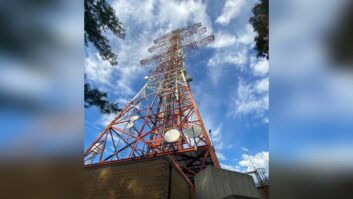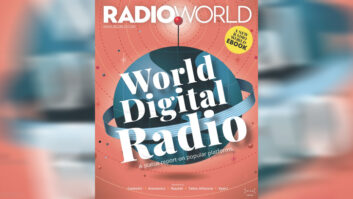Once touted as the “Savior of Shortwave,” Digital Radio Mondiale has not lived up to its hype. Proposed in 1988, with early field-testing in 2000, inaugural broadcasting in 2001 and its official rollout in 2003, DRM has had a lackluster career over the last decade.
With the allure of FM-quality audio and fade-free operation, it had appeared that DRM might revive the shortwave community. Unfortunately, it has been overcome by other events, some technical and some social. The main weakness has been alternate sources of information and entertainment, fueled by the very technology that gave DRM hope.
Additionally, in areas of the world without ubiquitous social media, DRM has yet to realize receivers at a moderate cost with adequate battery life. The very processing technology that allows improved operation using the more complex DRM waveform costs more and consumes more power than the standard AM receiver. A quick look at standalone DRM receivers over the past decade shows almost a dozen companies entering the market, only to retreat when the promise didn’t materialize.
A DEMAND AND A HOPE
If you mention “shortwave,” the average person pictures a wiry-looking “ham radio operator” in a basement or attic. But in fact, most of the less-developed world listens to shortwave. Outside the U.S., shortwave has been, and probably will continue to be, a serious contender for disseminating entertainment and information.
The rise of the Internet has influenced many broadcasters to cease their shortwave transmissions in favor of broadcasting over the World Wide Web. When BBC World Service discontinued service to Europe, North America, Australasia and the Caribbean, it generated many protests. The shifting of resources from shortwave to Internet and television by the Broadcasting Board of Governors, which oversees U.S. international broadcasting, further reduced broadcasting hours in the English language. With recent budget slashings of 70 to 80 percent, resulting in announcements of closing large stations such as the Radio Netherlands Bonaire and Radio Canada Sackville sites, increased pressure has been placed on shortwave to perform. Although most of the prominent broadcasters continue to scale back their analog shortwave transmissions or completely terminate them, shortwave is still common and active in developing regions, such as parts of Africa and South America.
Examining both the location of DRM stations and target areas, Fig. 1 shows that most DRM shortwave stations and target areas are in Europe. Until an inexpensive, battery-conscious receiver is available, continents such as South America and Africa won’t be viable target areas.

Fig. 1: Number and target areas of DRM shortwave stations.
Adil Mina, VP of business development for Continental Electronics, chairs the DRM USA Group. He has written on its website that “the receiver that all of us are looking for is still the small receiver, the inexpensive receiver that will have a good battery life. That’s what most people are looking for. It’s the one that should be like your BlackBerry, your telephone, that can sit for two days, three days, without you having to go back and charge it.”
IN PURSUIT OF QUALITY
The main requirement of DRM development was to ensure that far greater audio quality could be achieved whilst keeping the transmissions in a form to operate alongside existing AM transmissions. This meant having the ability for the transmissions to occupy a variety of different bandwidths dependent upon the location and frequencies in use.
There are two main elements to the DRM waveform: audio coding and RF modulation. Along came several leaps in technology to compress CD audio into a manageable size. Improved computer technology also provided the necessary processing speed to adopt a complex waveform. However, with higher processing speed comes increased cost and battery consumption.
AUDIO CODING AND COMPRESSION
DRM’s audio compression system employs two main techniques. The first is called Advanced Audio Coding. The brain does not perceive all the sounds that are heard by the ear. A strong sound on one frequency, for instance, will mask out others close in frequency that may be weaker. AAC analyzes the audio spectrum in sections and only encodes those sounds that will be perceived. However AAC on its own does not provide sufficient compression of the data to enable the transmissions to be contained within narrow shortwave bandwidths.
To provide the additional data compression, a scheme known as Spectral Band Replication is employed. This analyzes the sounds in the highest octave, which are normally from sounds such as percussion instruments of those that are harmonically related to other sounds lower in frequency. SBR analyzes them and sends data to the receiver that will enable them to be reconstituted later.
COFDM
The DRM transmitted signal uses a form of modulation known as Coded Orthogonal Frequency Division Multiplexing, as seen in Fig. 2. It is resilient to many common forms of interference and fading. Its main drawback has been that it requires a significant level of signal processing to extract the data from the carriers and reassemble it in the correct fashion. Signal processing ICs are now sufficiently powerful and are at a reasonable cost to make the use of this form of modulation viable.

Fig. 2: The COFDM Spectrum of a DRM signal
COFDM uses a large number of closely-spaced carriers that are modulated at a low rate data. Each carrier is modulated with Quadrature Amplitude Modulation using a selectable error coding. Normally, closely-spaced signals would be expected to interfere with each other, but by making the signals orthogonal to each another, there is no mutual interference. This is achieved by having the carrier spacing equal to the reciprocal of the symbol period. The data to be transmitted is split across all the carriers. By using error correction techniques, if some of the carriers are lost due to multi-path fading effects, then the data can be reconstructed.
COFDM has gained a significant presence in the wireless market place. It is now popular with wideband digital communication, digital television and audio broadcasting, DSL broadband Internet access, wireless networks and 4G mobile communications. The combination of high data capacity, high spectral efficiency and resilience to interference as a result of multi-path effects makes it ideal for the high data applications that are becoming common in today’s communications scene.
This signalling and detection technique incorporates kinematic filtering and signal multiplexing, aptly named “kineplex.” In the early 1950s Collins Radio foresaw the need to transmit data over relatively narrow channels. The 16-tone Tactical Digital Information Link, TADIL-A, is used by the U.S. Navy to share radar tracking data, which makes a classic buzz sound like an alligator happily making little ’gators. It’s one of the more distinctive sounds on shortwave. The receiving end of the link used a bank of 15 extremely-sensitive electromechanical resonators, housed in an equipment cabinet six feet high by three feet wide by two feet deep.
Receivers have come a long way since then.
NEW MODELS
DRM receivers evolved from front-end down-converters feeding personal computers. Later, digital signal processor manufacturers started producing chip sets containing both the DSP and the RF digitizer. Standalone receivers used these chip sets or modules without the PC.

Fig. 4:The DRM software radio uses an RF down-converter ahead of the sound card in a standard PC.
Initially, many firms tried to “seed” the shortwave market by offering “add-on” accessories to use the down-converter of existing higher-end receivers and adding a complex processor at the IF, as shown in Fig. 4. The bandwidth of a DRM signal varies from 9 kHz to 20 kHz, and the number of carriers used in the COFDM-modulation is relatively small (a maximum of 460 at the highest bandwidth vs. lowest carrier spacing options). These features motivated a real-time software implementation of a DRM-receiver on a conventional personal computer using the sound card as the input and output device. A long-, medium- and shortwave front end with an intermediate frequency (IF) between 5 kHz and 15 kHz is used to receive the DRM signal. This addressed the technically-adept, but didn’t apply to the villager starving for entertainment.

Fig. 5:The Coding Technologies Digital World Traveller was a convenient shortwave accessory for the traveler with a PC on the go.
One of the more-interesting DRM modules was the Digital World Traveller, Fig. 5, by Coding Technologies introduced in 2004. This handy little module was connected to the USB port of a PC or Notebook. Priced at $260, the device came with software capable of receiving DRM, FM and AM radio programs without any additional power supply or battery.

Fig. 3:The evolution of DRM ‘standalone’ shortwave portable receivers has left many artifacts behind.
Around 2007, a few manufacturers started selling standalone receivers (Himalaya Electronics, Technisat, Morphy Richards, Starwaves, UniWave, Sarapulsky Radiozavod). Most of the receivers were based upon the discontinued Radioscape RS500 module. The standalone models relied on household electricity and thus were not portable, as seen in Fig. 3. We do see a steady price reduction headed for the magic $100 goal (in production quantities, and not including taxes, V.A.T. or shipping).
PROCESSING GIANTS
DSPs can be found in most of our day-to-day consumer devices, including mobile handsets, digital cameras, navigation devices, TVs, DVD players and game consoles. They are ubiquitous in multimedia, telecommunications and networking applications. These products use a variety of hardware approaches to implement DSP, ranging from the use of off-the-shelf microprocessors to field-programmable gate arrays (FPGAs) to custom integrated circuits.
Programmable “DSP processors,” a class of microprocessors optimized for DSP, are a popular solution for several reasons. In comparison to fixed-function solutions, they have the advantage of potentially being reprogrammed in the field, allowing product upgrades or fixes. They are often more cost-effective (and less risky) than custom hardware, particularly for low-volume applications, where the development cost of custom ICs may be prohibitive.
The lowest complexity processors are “hard-wired” or dedicated processors such as FPGAs, lacking the flexibility to be reprogrammed should the DRM specification change. This was the nemesis for Digital Audio Broadcasting (DAB, Eureka-47), where dedicated chip sets specifically developed for DAB were termed worthless when the standard was updated, leaving receiver manufacturers reluctant to enter an immature arena.
Cutting-edge technology can allow a DSP to have lower power than the equivalent ASIC, due to the ASIC using older technology. Also, the DSP can usually be controlled to minimize clock speeds when the processing load allows.Alternatively, the power in an ASIC is minimized by ensuring that the signal-processing operations are dimensioned correctly, particularly in terms of the bit widths being processed.
FUTURE OF DRM?
The success of DRM is dependent on a combination of satisfying a need and technology arriving with the ability to fit that need. In order to provide better quality, a more complex carrier signal and additional processing was required. The need was to provide a better service, but the very enabling technologies also provided alternate forms of entertainment and information. Within the last decade’s window of opportunity DRM took one step forward and other mass media took several steps forward.
In a developed country, the speed of development favors the Internet because of rapid acceptance of service. The hardware is inexpensive, the bandwidth is expanding and the social media networks have been providing the individualized services that people demand. Given a limited budget for a household in an undeveloped country, they will try to maximize their “bang for the buck.”
With the advent of the Internet and SmartPhones and social media networks, all bets are off. We have recently seen the value of social media networks in social uprisings in the Middle East and Africa. People can get the same shortwave information over social media with the uncensored spontaneity of amateurs.
Without a viable (cost and battery-conscious) receiver, DRM has a hazy future.
Ernie Franke is a broadcast consultant in St. Petersburg, Fla. He earned a master’s degree in electrical engineering and has been the chief engineer at several broadcast stations.







